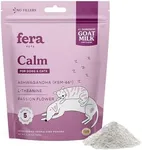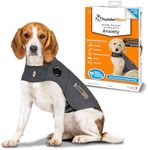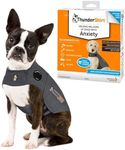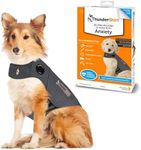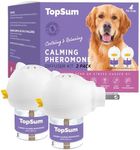Buying Guide for the Best Dog Anxiety Treatment
Choosing the right dog anxiety treatment can make a big difference in your pet’s well-being. There are many options available, from natural remedies to behavioral aids and even prescription medications. The best approach is to understand your dog’s specific needs, the severity of their anxiety, and your lifestyle. It’s important to consider how your dog reacts to different situations, such as being left alone, loud noises, or meeting new people. Always consult with a veterinarian before starting any new treatment, especially if your dog has underlying health conditions.Type of TreatmentThe type of treatment refers to the general approach used to help manage your dog's anxiety. This can include natural supplements, calming chews, pheromone diffusers, anxiety wraps, behavioral training aids, or prescription medications. Each type works differently: natural remedies and chews are often used for mild anxiety, while prescription medications are reserved for more severe cases. To choose the right type, consider how intense your dog’s anxiety is and whether you prefer a natural or medical approach. For mild, occasional anxiety, natural options or training aids may be enough, but for ongoing or severe anxiety, you may need to explore medical treatments with your vet.
Form of AdministrationThis spec describes how the treatment is given to your dog, such as oral chews, sprays, collars, diffusers, or wearable wraps. Some dogs are picky eaters and may not take chews easily, while others might be sensitive to wearing wraps or collars. If your dog is food-motivated, chews or treats can be a good choice. For dogs that dislike taking things by mouth, diffusers or sprays that release calming scents into the environment can be more suitable. Consider your dog’s temperament and daily routine when deciding which form will be easiest and most effective.
Duration of EffectDuration of effect refers to how long the treatment works after it is given or applied. Some treatments, like calming chews, may last a few hours, while others, like collars or diffusers, can provide continuous support for weeks. If your dog’s anxiety is triggered by specific events (like thunderstorms), a short-acting treatment may be enough. For dogs with ongoing anxiety, a longer-lasting option might be better. Think about when and how often your dog experiences anxiety to help you pick the right duration.
Ingredients or Active ComponentsThis spec covers what the treatment is made of, such as natural herbs, pheromones, or pharmaceutical ingredients. Some dogs may have allergies or sensitivities, so it’s important to check the ingredient list. Natural ingredients like chamomile or L-theanine are often used for mild anxiety, while prescription medications contain stronger active components. If you prefer a gentle approach or your dog has a sensitive stomach, look for treatments with simple, natural ingredients. For more severe cases, your vet may recommend specific medications.
Intended Use or Targeted AnxietyThis describes what kind of anxiety the treatment is designed to address, such as separation anxiety, noise phobias, travel stress, or general nervousness. Some products are formulated for specific triggers, while others are more general. If your dog only gets anxious during car rides, look for treatments labeled for travel. For dogs with multiple triggers, a broader solution may be needed. Understanding your dog’s main anxiety triggers will help you choose a treatment that targets their specific needs.



